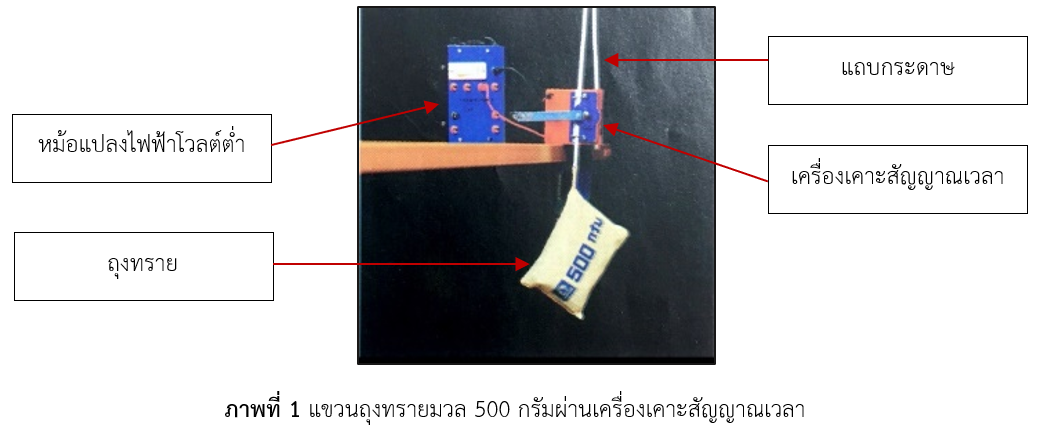การสร้างและการใช้เกณฑ์ประเมินคำอธิบายเชิงวิทยาศาสตร์สำหรับแนวคิด เรื่อง การเคลื่อนที่และแรงของนักเรียนชั้นมัธยมศึกษาปีที่ 5
Main Article Content
บทคัดย่อ
การวิจัยนี้มีวัตถุประสงค์เพื่อสร้างและใช้เกณฑ์ประเมินคำอธิบายเชิงวิทยาศาสตร์สำหรับแนวคิดเรื่องการเคลื่อนที่และแรง ตามกรอบแนวคิดของ McNeill และ Krajcik หลังการจัดกิจกรรมการเรียนรู้แบบสืบเสาะหาความรู้ กลุ่มตัวอย่างถูกเลือกแบบเจาะจงจากชั้นมัธยมศึกษาปีที่ 5 จำนวน 67 คนที่เรียนรายวิชาวิทยาศาสตร์กายภาพ (ฟิสิกส์) ภาคเรียนที่ 1 ปีการศึกษา 2563 เครื่องมือที่ใช้ในการวิจัย ได้แก่ แผนการจัดการเรียนรู้การทดลองแบบสืบเสาะหาความรู้จำนวน 3 แผน และแบบประเมินการสร้างคำอธิบายเชิงวิทยาศาสตร์ 4 ข้อ ได้แก่ (1) การเคลื่อนที่ของวัตถุในแนวดิ่งภายใต้แรงโน้มถ่วงของโลก (2) ความสัมพันธ์ระหว่างแรง มวล และความเร่ง (3) การหาขนาดและทิศทางของแรงลัพธ์ของแรงสองแรง และ (4) การเคลื่อนที่แนวโค้งภายใต้แรงโน้มถ่วงของโลก ผลการวิจัยพบว่า เกณฑ์การวิเคราะห์การสร้างคำอธิบายเชิงวิทยาศาสตร์จากกระบวนการของกลุ่มผู้เชี่ยวชาญมีประสิทธิภาพ และมีความเป็นปรนัยและแปรผลง่ายในการนำไปใช้ เมื่อนำเกณฑ์การวิเคราะห์การสร้างคำอธิบายเชิงวิทยาศาสตร์นี้ไปใช้กับกลุ่มตัวอย่างพบว่านักเรียนได้คะแนนข้อสรุปหรือข้อกล่าวอ้าง หลักฐาน และการให้เหตุผล ร้อยละ 75.2 3.92 และ 66.2 ตามลำดับ
Article Details

อนุญาตภายใต้เงื่อนไข Creative Commons Attribution-NonCommercial-NoDerivatives 4.0 International License.
วารสารวิทยาศาสตร์และวิทยาศาสตร์ศึกษา (JSSE) เป็นผู้ถือลิสิทธิ์บทความทุกบทความที่เผยแพร่ใน JSSE นี้ ทั้งนี้ ผู้เขียนจะต้องส่งแบบโอนลิขสิทธิ์บทความฉบับที่มีรายมือชื่อของผู้เขียนหลักหรือผู้ที่ได้รับมอบอำนาจแทนผู้เขียนทุกนให้กับ JSSE ก่อนที่บทความจะมีการเผยแพร่ผ่านเว็บไซต์ของวารสาร
แบบโอนลิขสิทธิ์บทความ (Copyright Transfer Form)
ทางวารสาร JSSE ได้กำหนดให้มีการกรอกแบบโอนลิขสิทธิ์บทความให้ครบถ้วนและส่งมายังกองบรรณาธิการในข้อมูลเสริม (supplementary data) พร้อมกับนิพนธ์ต้นฉบับ (manuscript) ที่ส่งมาขอรับการตีพิมพ์ ทั้งนี้ ผู้เขียนหลัก (corresponding authors) หรือผู้รับมอบอำนาจ (ในฐานะตัวแทนของผู้เขียนทุกคน) สามารถดำเนินการโอนลิขสิทธิ์บทความแทนผู้เขียนทั้งหมดได้ ซึ่งสามารถอัพโหลดไฟล์บทความต้นฉบับ (Manuscript) และไฟล์แบบโอนลิขสิทธิ์บทความ (Copyright Transfer Form) ในเมนู “Upload Submission” ดังนี้
1. อัพโหลดไฟล์บทความต้นฉบับ (Manuscript) ในเมนูย่อย Article Component > Article Text
2. อัพโหลดไฟล์แบบโอนลิขสิทธิ์บทความ (Copyright Transfer Form) ในเมนูย่อย Article Component > Other
ดาวน์โหลด ไฟล์แบบโอนลิขสิทธิ์บทความ (Copyright Transfer Form)
เอกสารอ้างอิง
American Association for the Advancement of Science. (1991). Science for all Americans. New York: Oxford University.
Bell, P. and Linn, M. C. (2000). Scientific arguments as learning artifacts: Designing for learning from the web with KIE. International journal of science education, 22(8), 797-817.
Driver, R., Newton, P. and Osborne, J. (2000). Establishing the norms of scientific argumentation in classrooms. Science education, 84(3), 287-312.
Frensley, J. (2019). ABCD’s of explaining your reasoning. The Physics Teacher, 57(3), 202-202.
Juthanarupakit, K., Jantarakantee, A. and Chiangka, S. (2018). Implementing scientific inquiry approaches to develop grade 10th students’ scientific explanation in the topic of circular motion (in Thai). Rangsit Graduate Research Conference (pp. 1741-1753). Bangkok: Rangsit University.
Ladachart, L., Chimphali, K., Aryowong, N., Ngaewkoodrua, N., Srakhao, S., Wangead, C. and Thammaprateep, J. (2015). Ninth Grade Student’ Making Scientific Inferences and Explanations (in Thai). Silpakorn University Journal, 171-206.
Limpijumnong, C. (2019). Physical Science 2 (in Thai). Bangkok: Chulalongkorn University Press.
Liwkongsatapond, W. (2021). Scientific explanation (In Thai). Retrieved 1 May 2021, from Library.IPST: https://library.ipst.ac.th/handle/ipst/1365.
McNeill, K. L. and Krajcik, J. (2006). Supporting students’ construction of scientific explanation through generic versus context-specific written scaffolds. Annual Meeting of the American Educational Research Association. San Francisco: American Educational Research Association.
National Research Council. (1996). National science education standards. Washington, D.C.: National Academy of Science.
National Research Council. (2013). Next generation science standards: For state, by state. Washington, D.C.: National Academy of Science.
National Research Council. (2000). Inquiry and the national science education standards: A guide for teaching and learning. Washington, D.C.: National Academy of Science.
Peker, D. and Wallace C.S. (2011). Characterizing high school students’ written explanations in biology laboratories. Research in Science Education, 41(2), 169-191.
Phornphisutthimas, S. (2013). Learning management of science in 21st century (In Thai). Journal of Research Unit on Science, Technology and Environment for Learning, 4(1), 55-63.
Pornsuriwong, S. and Sungthong, A. (2020). The results of learning activities using STEM education of motion in physics for grade-11 students (in Thai). Journal of Science and Science Education, 3(1), 30-40.
Ruangbun, T. and Wuttiprom, S. (2016). Designing and Developing Electromagnetic Induction Projectile Launcher (In Thai). Journal of Research Unit on Science, Technology and Environment for learning, 7(1), 191-203.
Ruiz‐Primo, M. A., Li, M., Tsai, S. P. and Schneider, J. (2010). Testing one premise of scientific inquiry in science classrooms: Examining students' scientific explanations and student learning. Journal of Research in Science Teaching, 47(5), 583-608.
Wongchaiya, K. (2016). Effects of predict-explain-observe-explain-discuss of Galvanic cells on the improvement of Grade 12 student’ science process skills (in Thai). Master’s Thesis. Ubon Ratchathani: Ubon Ratchathani University.
Wuttiprom, S. (2013). A Comparison of Teaching Experiments between Videotaped and Demonstrative Approaches in Developing Scientific Concepts about Buoyant Force (in Thai). Journal of Research Unit on Science, Technology and Environment for learning, 4(1), 7-17.
Zohar, A. and Nemet, F. (2002). Fostering students' knowledge and argumentation skills through dilemmas in human genetics. Journal of Research in Science Teaching, 39(1), 35-62.


